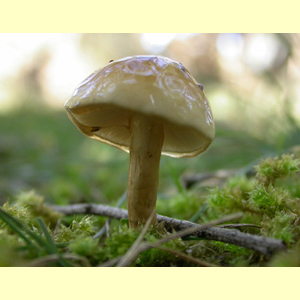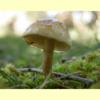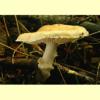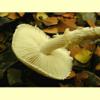
images/Limacella/Limacella_illinita.jpg





Diagnostic characters
Small to large (mostly medium) agaric, growing on the ground, with a white spore print. Pileus white or pale, sometimes with brownish tints in centre, viscid or glutinous when fresh. Lamellae free, adnexed or adnate. Stipe central. Partial veil remnants a ring zone, a membranous annulus or absent. Spores hyaline, non-amyloid, rarely dextrinoid, smooth or warty; germ pore absent. Cheilocystidia absent. Lamellar trama interwoven or bilateral. Pileipellis a trichoderm. Clamp connections present.
Similar genera
Limacella is closest to Amanita, with which it shares the bilateral lamellar trama, but it differs in the absence of a volva, the constantly viscid to glutinous pileus (lacking membranous patches or scales) and the spores sometimes being warty. Limacella differs from Oudemansiella (other) by the absence of a pseudorhiza and from most other ground-inhabiting, white-spored agarics with viscid to glutinous pileus by the bilateral lamellar trama and the absence of cheilocystidia. Limacella pitereka should be compared to Hygrophorus involutus, which has weakly-developed bilateral lamellar trama, but differs in the uniform pileus colour (not with the pileus centre tinted yellowish or brownish) and the usually yellow (rather than white) lamellae.
Citation
Limacella Earle, Bull. New York Bot. Gard. 5: 447 (1909).
Australian species
One named species: Limacella pitereka (misidentified as Hygrophorus candidus and also recorded in Australian literature as L. illinita, and possibly also as L. ochraceolutea), and at least one un-named species (with a dry stipe and annulus and finely roughened spores). Records of L. guttata require confirmation.
Australian distribution
W.A., S.A., Qld, N.S.W., Vic. and Tas. (and probably also N.T.).
Habitat
In native forests.
Substrate
On the ground.
Trophic status
Saprotrophic.
References
Bougher, N.L. (2009a), Fungi of the Perth region and beyond: a self-managed field book, Western Australian Naturalists' Club (Inc.), Perth. [Description and Illustration of L. pitereka]
Breitenbach, J. & Kränzlin, F. (eds) (1995), Fungi of Switzerland. Volume 4. Agarics 2nd part. Edition Mykologia, Lucerne. [Illustration, Description and Microcharacters of five European species, including L. illinita]
Fuhrer, B. (2005), A Field Guide to Australian Fungi. Bloomings Books, Hawthorn. [Description and Illustration of L. pitereka and an unnamed species]
Grgurinovic, C.A. (1997a), Larger Fungi of South Australia. The Botanic Gardens of Adelaide and State Herbarium and The Flora and Fauna of South Australia Handbooks Committee, Adelaide. [Description and Microcharacters of L. piterika]
McCann, I.R. (2003), Australian Fungi Illustrated. Macdown Productions, Vermont. [Illustration of Limacella piterika, as Limacella sp.]
